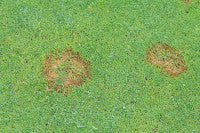Fast action stops Fusarium
 Fusarium pathogens ever present in the thatch layer are just waiting for the right turf and weather conditions to breakout into infection, with damaging symptoms seemingly appearing overnight. Ian Coote, Head Greenkeeper at Royston Golf Club, reports Headway treatments have been effective in stopping development and preventing disease spread.
Fusarium pathogens ever present in the thatch layer are just waiting for the right turf and weather conditions to breakout into infection, with damaging symptoms seemingly appearing overnight. Ian Coote, Head Greenkeeper at Royston Golf Club, reports Headway treatments have been effective in stopping development and preventing disease spread.
Quick action with an application of Headway stopped an early autumn attack of Fusarium Patch dead in its tracks and should give sufficient time for the green to recover before the rigours of winter, reports Royston Golf Club Head Greenkeeper, Ian Coote.
Within 24 hours of application the visible symptoms of Fusarium had stopped spreading, and three days later healthy new leaf was growing through the yellowed areas, without ever developing to dead patches and loss of putting surface quality. "I've never seen any fungicide work so quickly and so effectively," he says.
Ian knows the greens most susceptible to disease and uses them as an indicator as to when infection pressure is high and widespread outbreaks expected. Identification guides and disease control technical information is pinned on the staff room wall, so the entire greenkeeping team are well aware of what to look out for when mowing or switching greens.
"We also display the GreenCast website on the computer every morning, which is useful to highlight when disease risk is high and when we need to be especially wary for the first symptoms of any outbreak," he adds. "With the detailed weather, disease forecasting and spray window information we find it a really useful tool to help with everyday decisions."
The Hertfordshire club's combination of more proactive disease forecasting and early treatment, especially focussed on the most susceptible greens, has enabled Ian and his agronomist, Mike Williamson of Sherriff Amenity, to reduce overall level of fungicide use, and produce what club members are saying are the best greens quality for over 30 years.
It's a strategy that is especially important since the whole area on a chalk downland is a Site of Special Scientific Interest (SSSI) and subject to an incredibly detailed management plan, created by STRI ecologists and operated in agreement with Natural England. The entire course and surrounding area is open to free public access.
"Minimising the use of any inputs, including fungicides and fertilisers, is an integral part of the plan," reports Ian. "If we can get more effective and longer lasting control from better timing of products such as Headway, then it helps with the environmental aspect and the economics of the management."
Allied to this fungicide approach, Ian and Mike have adapted the fertiliser use to match nutrient inputs, especially nitrogen, to the grass growth curve. A slow release fertiliser in the spring is topped up with liquid feeds as required through the season, with an additional slow release application at renovation time in early autumn.
Mike Williamson highlights they have cut down significantly on the overall level of nitrogen applied. "The aim of this and allied Primo Maxx programme is to avoid the lush growth that is most susceptible to Fusarium. But with the summer foliar feeds we can ensure there is sufficient nutrient to avoid stress on the turf, which could encourage anthracnose and Dollar Spot," he advises. The club has a history of Dollar Spot infection on some greens which, with the tailored fertiliser and fungicide programme, has been avoided this summer.
 Ian Coote adds that an over seeding programme using Fescue grass species is also paying dividends in reducing the percentage of more disease susceptible Poa annua in the greens, and is also helping to keep them looking better during dry periods when the Poa particularly suffers. "We are ideally looking to get the content up to 60 to 65% Fescue, which we have nearly achieved on some greens, and the playing quality is living up to the Club's renowned reputation for 'hard and fast' greens."
Ian Coote adds that an over seeding programme using Fescue grass species is also paying dividends in reducing the percentage of more disease susceptible Poa annua in the greens, and is also helping to keep them looking better during dry periods when the Poa particularly suffers. "We are ideally looking to get the content up to 60 to 65% Fescue, which we have nearly achieved on some greens, and the playing quality is living up to the Club's renowned reputation for 'hard and fast' greens."
To further improve the consistent quality Ian is now looking at Rescue herbicide treatments on some of the greens where Ryegrass spread from surrounds, banks and some fairway areas is affecting the fine turf quality.
"We did a Rescue trial on a green surround area earlier in the year, and the results have been quite incredible in removing the Ryegrass and allowing the Fescue to recover and fill the gaps," recall Ian. Stopping the spread of invasive Ryegrass on the greens will be an essential element of increasing the Fescue component, and could have an important role in preserving the valuable and unique chalk grassland habitat.
For UK specific turf agronomy and product information go to www.greencast.co.uk
